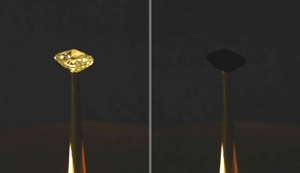MIT engineers develop “blackest black” material to date
13. 9. 2019 | MIT | www.mit.edu
MIT engineers report today that they have cooked up a material that is 10 times blacker than anything that has previously been reported. The material is made from vertically aligned carbon nanotubes, or CNTs — microscopic filaments of carbon, like a fuzzy forest of tiny trees, that the team grew on a surface of chlorine-etched aluminum foil. The foil captures more than 99.96 percent of any incoming light, making it the blackest material on record.
The artwork, a collaboration between Brian Wardle, professor of aeronautics and astronautics at MIT, and his group, and MIT artist-in-residence Diemut Strebe, features a 16.78-carat natural yellow diamond, estimated to be worth $2 million, which the team coated with the new, ultrablack CNT material. The effect is arresting: The gem, normally brilliantly faceted, appears as a flat, black void.

The material is already gaining interest in the aerospace community. Astrophysicist and Nobel laureate John Mather, who was not involved in the research, is exploring the possibility of using Wardle’s material as the basis for a star shade — a massive black shade that would shield a space telescope from stray light.
Read more at MIT
Image Credit: R. Capanna, A. Berlato, A. Pinato
-jk-




